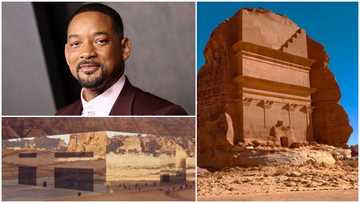Elmina Castle, Cape Coast Castle And Other World Heritage Sites In Ghana With Great Historical Significance
- Ghana boasts of impressive structures like the Elmina Castle and Cape Coast Castle, which have been declared UNESCO World Heritage Sites
- World Heritage Sites are places or buildings thought to have unique cultural or natural importance and are expected to mean more to future generations
- The Heritage Sites found in Ghana are centuries old and hold some of the country's profound culture and history
PAY ATTENTION: Enjoy reading our stories? Join YEN.com.gh's Telegram channel for more!
Ghana has several places and buildings with precious national memories, some of which have been named UNESCO World Heritage Sites. Some of Ghana's UNESCO World Heritage Sites are centuries old and have become tourist centres attracting locals and foreigners alike. In this story, YEN.com.gh mentions the UNESCO World Heritage Sites in Ghana.
Elmina Castle in the Central Region of Ghana

Source: Getty Images
The Elmina Castle in the Central Region of Ghana is arguably the oldest known European building in sub-Saharan Africa. It was also the first trading post built in the Gulf of Guinea and was first established as a trading settlement by Portuguese merchants in 1842.

Read also
Will Smith tours Saudi Arabia and visits unusual buildings like world's largest mirrored building
The castle later became known as a notorious station in the Atlantean captive trade. The Dutch ruled the fort from 1647 until 1872 when the British Empire took over.
PAY ATTENTION: Сheck out news that is picked exactly for YOU ➡️ click on “Recommended for you” and enjoy!
Ghana gained independence from Britain in 1957 and took control of the castle. It was declared a UNESCO World Heritage Site in 1979. This structure, which tells how Europeans first came to Ghana and built their structures, has been meticulously handled.

Source: Getty Images
There is also a history of how enslaved people were held in the castle, waiting to be shipped off across the ocean to plantations in America.
Several celebrities worldwide visited the Elmina Castle in 2019 during the Year of Return program, including Steve Harvey, who was moved to tears when he saw the facility.
Cape Coast Castle in the Central Region of Ghana

Source: Getty Images
The Cape Coast Castle was built in 1653 by the Swedes as a store for exchanging wood and gold, but later, it became a holding station for enslaved people after it was captured by the British in 1665, who upgraded it to a castle by 1700.

Read also
Stamford Bridge, Estádio do Dragão and 2 other top European stadia where Christian Atsu played
Enslaved people were kept at the castle before being loaded onto slave ships and sold in America and the Caribbeans.

Source: Getty Images
The castle served as the British Governor's seat, and in the 18th century, the castle's role changed and became the centre of European education in Ghana. It became the West African headquarters of the president of the Committee of Merchants and a school, temporarily.
The castle is open to the public and is now a historical museum with a gift shop selling Ghanaian artefacts. The Cape Coast Castle also serves as the regional headquarters of the Ghana Museums and Monuments Commission.
Asante Traditional Buildings in the Ashanti Region

Source: Getty Images
The Asante Traditional Buildings are found in the Ashanti Region of Ghana. The buildings have ten shrines and were declared a UNESCO World Heritage Site in 1980.
The mud shrines have roofs of woven palm leaves and are generally astonishing for their detailed architectural plans and their stylised animal symbols.

Source: Getty Images
The dirt, wood and straw used to construct the buildings are the last material remnants of the great Asante civilisation, which peaked in the 18th century. They are now subject to deterioration caused by time and harsh weather.
Speaking exclusively to YEN.com.gh, Mr Benaiah Cathline-Abraham, a facility manager at a real estate company in Ghana called C-Quiver Properties, spoke about the need to preserve these historical sites. He explained:
It is important to preserve the buildings that make up the World Heritage Sites in Ghana. They are impressive because they were built with technology at the time. Today, most of the local chiefs still live in palaces that were built several years ago. Modern architecture may have moved on, but we must have a maintenance culture that preserves these monuments for many generations. The dungeons in the castles could be painted regularly with lights fixed in them so that we could see what the enslaved could not.
The traditional religion still practised in the Asante shrines involves consulting the gods for advice in specific situations or before important events. As such, the shrine has been preserved with all its iconic features.
Other buildings nominated by Ghana to become World Heritage Sites
Over the years, the Ghana Tourism Board has presented a new list of tourist attractions and historical sites requesting UNESCO to recognise them as World Heritage Sites. These are the recommended sites and their nomination dates.

Read also
Ghanaian man wins 2023 African Hero's Award, the same honour Nelson Mandela was given in 1991
Name of Landmark | Nomination Date |
Kakum National Park | 17th January 2000 |
Mole National Park | 17th January 2000 |
Navrongo Catholic Cathedral | 17th January 2000 |
Nzulezu Stilt Settlement | 17th January 2000 |
Trade Pilgrimage Routes of North-Western Ghana | 17th January 2000 |
Tengzug - Tallensi settlements | 17th January 2000 |
12 most beautiful places in Ghana to visit
In an earlier story, YEN.com.gh wrote about the most beautiful places in Ghana that people should visit. Ghana's beautiful places are much more than mere tourist attractions, as most people assume. They are filled with rich history and culture that make the country unique from others. Ghana has stunning landscapes, historically rich culture displayed in museums and beautiful sandy beaches by the sea, which make it one of the most beautiful places on earth.
New feature: Сheck out news that is picked for YOU ➡️ click on “Recommended for you” and enjoy!
Source: YEN.com.gh


